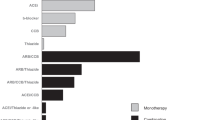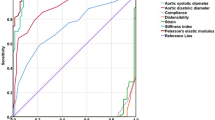Abstract
Although evidence from basic research suggests the involvement of angiotensin II (Ang II) in the progression of arteriosclerosis, the clinical data are limited. In the present study, hypertensive outpatients who were well controlled with antihypertensive medication and had similar blood pressure levels were studied, and arterial elasticity was compared between those receiving Ang II receptor blockers (ARBs) and those treated with other antihypertensive agents. The effects of HMG-CoA reductase inhibitors (STs) on arterial elasticity were also evaluated. The study enrolled 298 outpatients who had been diagnosed with essential hypertension whose blood pressure was controlled to 150/95 or less by antihypertensive treatment (excluding angiotensin converting enzyme [ACE] inhibitors) for at least 2 months. The small artery elasticity index (SAEI) was determined for each patient from the radial artery pulse waves using a non-invasive pulse wave analysis system CR-2000. The mean of two blood pressure measurements taken from subjects lying in a recumbent position during SAEI analysis was used for the data analysis. The patients were grouped according to the use of ARBs and STs, and two-way analysis of variance (ANOVA) was used for statistical comparisons. A backward stepwise multiple regression analysis was carried out to identify factors contributing to the SAEI. Hypertensive patients receiving ARB treatment had a significantly higher SAEI compared to those not receiving ARBs, despite the similar blood pressure levels of both groups. No significant effects of ST treatment on the SAEI were observed (two-way ANOVA). A backward stepwise multiple regression analysis for the SAEI suggested that ARB treatment was an independent determinant of the SAEI after the adjusting of age, gender, total cholesterol, high density lipoprotein cholesterol, smoking and systolic blood pressure. Our results suggested that while providing blood pressure control similar to that of other antihypertensive agents, ARBs may also increase vascular elasticity and thereby delay the progression of arteriosclerosis.
Similar content being viewed by others
Article PDF
References
Wang YX, Fitch RM : Vascular stiffness: measurements, mechanisms and implications. Curr Vasc Pharmacol 2004; 2: 379–384.
Kohara K, Tabara Y, Tachibana R, et al: Microalbuminuria and arterial stiffness in a general population: the Shimanami Health Promoting Program (J-SHIPP) study. Hypertens Res 2004; 27: 471–477.
Cohn JN : Vascular wall function as a risk marker for cardiovascular disease. J Hypertens Suppl 1999; 17 ( 5): S41–S44.
Dzau VJ, Re R : Tissue angiotensin system in cardiovascular medicine. A paradigm shift? Circulation 1994; 89: 493–498.
Diet F, Pratt RE, Berry GJ, et al: Increased accumulation of tissue ACE in human atherosclerotic coronary artery disease. Circulation 1996; 94: 2756–2767.
Schmidt B, Drexler H, Schieffer B : Therapeutic effects of angiotensin (AT1) receptor antagonists: potential contribution of mechanisms other than AT1 receptor blockade. Am J Cardiovasc Drugs 2004; 4: 361–368.
Schupp M, Janke J, Clasen R, et al: Angiotensin type 1 receptor blockers induce peroxisome proliferator-activated receptor-gamma activity. Circulation 2004; 109: 2054–2057.
Miida T, Hirayama S, Nakamura Y : Cholesterol-independent effects of statins and new therapeutic targets: ischemic stroke and dementia. J Atheroscler Thromb 2004; 11: 253–264.
Rosenson RS, Tangney CC : Antiatherothrombotic properties of statins: implications for cardiovascular event reduction. JAMA 1998; 279: 1643–1650.
Cohn JN, Finkelstein S, McVeigh G, et al: Noninvasive pulse wave analysis for the early detection of vascular disease. Hypertension 1995; 26: 503–508.
Finkelstein SM, Collins VR, Cohn JN : Arterial vascular compliance response to vasodilators by Fourier and pulse contour analysis. Hypertension 1988; 12: 380–387.
McVeigh G, Brennan G, Hayes R, et al: Vascular abnormalities in non-insulin-dependent diabetes mellitus identified by arterial waveform analysis. Am J Med 1993; 95: 424–430.
Takeuchi K, Zhang B, Ideishi M, et al: Influence of age and hypertension on the association between small artery compliance and coronary artery disease. Am J Hypertens 2004; 17: 1188–1191.
Tham DM, Martin-McNulty B, Wang YX, et al: Angiotensin II injures the arterial wall causing increased aortic stiffening in apolipoprotein E-deficient mice. Am J Physiol Regul Integr Comp Physiol 2002; 283: R1442–R1449.
Dobrin PB, Rovick AA : Influence of vascular smooth muscle on contractile mechanics and elasticity of arteries. Am J Physiol 1969; 217: 1644–1651.
Cabrera E, Levenson J, Armentano R, et al: Aortic pulsatile pressure and diameter response to intravenous perfusions of angiotensin, norepinephrine, and epinephrine in conscious dogs. J Cardiovasc Pharmacol 1988; 12: 643–649.
Tham DM, Martin-McNulty B, Wang YX, et al: Angiotensin II is associated with activation of NF-kappaB-mediated genes and downregulation of PPARs. Physiol Genomics 2002; 11: 21–30.
Wang YX, Martin-McNulty B, Freay AD, et al: Angiotensin II increases urokinase-type plasminogen activator expression and induces aneurysm in the abdominal aorta of apolipoprotein E-deficient mice. Am J Pathol 2001; 159: 1455–1464.
Carmeliet P, Moons L, Lijnen R, et al: Urokinase-generated plasmin activates matrix metalloproteinases during aneurysm formation. Nat Genet 1997; 17: 439–444.
Schneiderman J, Bordin GM, Engelberg I, et al: Expression of fibrinolytic genes in atherosclerotic abdominal aortic aneurysm wall. A possible mechanism for aneurysm expansion. J Clin Invest 1995; 96: 639–645.
Lage SG, Kopel L, Medeiros CC, et al: Angiotensin II contributes to arterial compliance in congestive heart failure. Am J Physiol Heart Circ Physiol 2002; 283: H1424–H1429.
Takami T, Shigemasa M : Efficacy of various antihypertensive agents as evaluated by indices of vascular stiffness in elderly hypertensive patients. Hypertens Res 2003; 26: 609–614.
Mahmud A, Feely J : Effect of angiotensin ii receptor blockade on arterial stiffness: beyond blood pressure reduction. Am J Hypertens 2002; 15: 1092–1095.
Shargorodsky M, Leibovitz E, Lubimov L, et al: Prolonged treatment with the AT1 receptor blocker, valsartan, increases small and large artery compliance in uncomplicated essential hypertension. Am J Hypertens 2002; 15: 1087–1091.
Ihara M, Urata H, Kinoshita A, et al: Increased chymase-dependent angiotensin II formation in human atherosclerotic aorta. Hypertension 1999; 33: 1399–1405.
Uehara Y, Urata H, Ideishi M, et al: Chymase inhibition suppresses high-cholesterol diet-induced lipid accumulation in the hamster aorta. Cardiovasc Res 2002; 55: 870–876.
Romney JS, Lewanczuk RZ : Vascular compliance is reduced in the early stages of type 1 diabetes. Diabetes Care 2001; 24: 2102–2106.
Duprez DA, De Buyzere ML, De Backer TL, et al: Relationship between arterial elasticity indices and carotid artery intima-media thickness. Am J Hypertens 2000; 13: 1226–1232.
Syeda B, Gottsauner-Wolf M, Denk S, et al: Arterial compliance: a diagnostic marker for atherosclerotic plaque burden? Am J Hypertens 2003; 16: 356–362.
MacMahon M, Kirkpatrick C, Cummings CE, et al: A pilot study with simvastatin and folic acid/vitamin B12 in preparation for the Study of the Effectiveness of Additional Reductions in Cholesterol and Homocysteine (SEARCH). Nutr Metab Cardiovasc Dis 2000; 10: 195–203.
Masumoto A, Hirooka Y, Hironaga K, et al: Effect of pravastatin on endothelial function in patients with coronary artery disease (cholesterol-independent effect of pravastatin). Am J Cardiol 2001; 88: 1291–1294.
Author information
Authors and Affiliations
Corresponding author
Rights and permissions
About this article
Cite this article
Takeuchi, K., Ideishi, M., Tashiro, T. et al. Higher Small Arterial Elasticity in Hypertensive Patients Treated with Angiotensin II Receptor Blockers. Hypertens Res 28, 639–644 (2005). https://doi.org/10.1291/hypres.28.639
Received:
Accepted:
Issue date:
DOI: https://doi.org/10.1291/hypres.28.639



